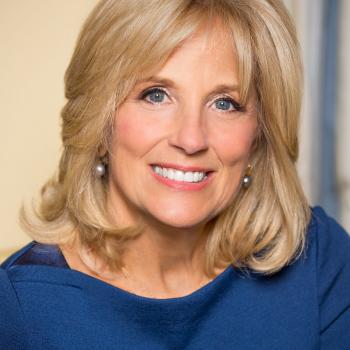One evening in 2014, South Carolina father Timothy Jones Jr. killed his five young children. I’ll leave out the details of the children’s murders; I am more interested in a larger point about these murders’ circumstances. The children lived with their father because their mother, Amber Kyzer, opted to let him have primary custody of the children when she ended her eight-year marriage.
After their marriage ended, [Kyzer] was left without a job, a car or a license, and believed it’d be best to give her former husband primary custody of the children, CNN affiliate WIS reported.
“I had nothing to offer my children, I could not provide for them,” she said. “As a mother, I made the best decision I could. I trusted my husband at the time. He promised to take care of our children.”
When you read on, you come to this:
[Kyzer] told the jury about the alleged abuse she suffered while married to Jones, sometimes in the presence of their children. She described how he used to spit on her, headbutt her and threaten to chop her up.
Kyzer left Jones over his increasingly abusive behavior. She says she thought that if she left—removing the toxicity of Jones’ treatment of her from her children’s daily experience—her children’s lives would improve. She had no idea, she says, that Jones would harm the children. But this wasn’t actually why she left Jones have custody. That she did because she didn’t think she’d be able to care for the children herself, as a single mom with five children and no job. She didn’t thinks he had any other option.
Remember welfare reform, in 1996? The new version of welfare, Temporary Assistance for Needy Families (TANF), added strict work requirements. No job, no money. Ironically, though, the old version of welfare, Aid to Families with Dependent Children (AFDC), was initially created with the intent to ensure that mothers could focus on raising their children without having to work.
In 1935, Congress created … Aid to Dependent Children, whose name was later changed to Aid to Families with Dependent Children. [AFDC] is what we typically think of as “welfare”—cash transfers intended to help widows with children.
…
AFDC was never flawless—it excluded black women until the 1960s—but it did become an important lifeline for poor mothers throughout the 1980s. By 1992, the majority of AFDC recipients were single mothers, rather than widows.
As more women entered the workforce, however, society began to sour on unemployed single mothers. Those drawing government benefits were derided as “welfare queens.”
“The expectation was that since middle-class women are working and supporting their families, that low-income families should be doing the same,” Moffitt told me.
Under this older system, Kyzer would not have had to get a job to receive welfare benefits from the government. In fact, there would have been a presumption that it was better for her to be at home caring for her five children—supported financially by a check from the government—than at work all day.
The sad irony is that the very people who pushed for welfare reform—social conservatives—were the same ones who were most critical of women entering the workforce. They didn’t expect middle class women to work—they wanted them to stay home and raise children. It was poor single mothers that conservatives wanted pushed into the workforce, which seems doubly odd given that these women’s lack of a parenting partner ought to have made it doubly important, within conservatives’ frame of reference, to ensure that they had the time and energy to effectively parent their children.
Perhaps conservatives’ drive to add work requirements to welfare was about punishing these women for having children out of wedlock—or for divorcing their husbands, as Kyzer did (roughly one-quarter of women who enrolled in welfare during the 1980s did so in connection with a divorce or separation). Perhaps they wanted to ensure that they weren’t motivating out of wedlock birth or divorce.
But it is women like Kyzer—and her children—who pay the price. I don’t know whether Kyzer ever considered what public assistance she’d have been eligible for, or what child support she would be eligible to receive from Jones. I do know that we as a society have not done enough to ensure that single mothers have the financial resources they need to raise their children—and she knew that.
Years ago, I volunteered at my local Planned Parenthood. After working as an escort, I helped for a while with intake. One woman who came in for an abortion told me that she believed that the life growing insider her was a person, and she didn’t want to kill it. But, she said, she worked a minimum wage job, already had four children, and couldn’t see how she could possibly care for one more. She had to kill her baby, she said, for the sake of the children she already had. She had no other option.
Conservatives seem to think that if we provide single mothers with the financial resources they need to raise their children without struggling with dire poverty, women would leave their husbands or boyfriends to go it alone willy nilly, leading to the destruction of the family. But women don’t leave their husbands or boyfriends for no reason, and being a single parent is difficult even apart from the financial challenges—there’s the lack of a secondary parent. No one wants to be a single parent.
Kyzer left her five children with a man she knew had violent tendencies because she couldn’t see any way for her to support the children herself. She didn’t think he would hurt them, she said—but, critically, she also didn’t think she had any other option. Our social welfare system failed Kyzer, and her children.
Let’s return more fully to Kyzer for a moment. While I couldn’t find any articles to state this directly, it is possible that Jones’ abuse was the reason Kyzer did not have a driver’s license. Abusers frequently work to keep their victims dependent on them. Did Kyzer bring up her abuse in the initial divorce and custody hearings? Would a judge have seen Kyzer’s lack of a driver’s license as a red flag?
As an abused women, Kyzer could have gone to a shelter and taken her children with her. But then, if a woman alleges abuse during custody hearings, she’s actually less likely to receive primary custody of her children than if she does not allege abuse. And what is the judge going to see? A mother with no job, no driver’s license, no nothing, and a father who looks like an upstanding family man, with a good job, a house, everything. The system was always stacked against Kyzer, and she likely knew it.
Those children were failed by their father, but they were also failed by a system that kept them in their father’s hands long after he began abusing his first victim, their mother.
As I set about wrapping up this post, I found this:
Amber Kyzer, mother to Merah, 8; Elias, 7; Nahtahn, 6; Gabriel, 2; and Abigail 1, testified Monday afternoon about her eight-year marriage to Jones, which ended in divorce in 2012.
She testified she met Jones when the pair was 19 and living in Chicago, working at the same children’s arcade. After six weeks of dating, Kyzer testified she and Jones got married, something she attributed to the Pentecostal church the two attended.
“Tim believed women were supposed to be fruitful and multiply,” she testified. “He felt like women should be seen and not heard. Tim was very goal oriented….I’m sorry…very smart, very smart man. Everything that he and set out to do as a goal he accomplished and I found that very honorable. That’s one of the main things that attracted me to him.”
The two moved from Illinois to Mississippi, where Jones attended Mississippi State University. By then, the two already had three children; Merah, Elias, and Nahtahn. When Jones got a job offer at Intel in Columbia, Kyzer testified the family moved to the Batesburg-Leesville area into a “rundown trailer that needed a lot of work.”
They would welcome two more children, Gabriel and Abigail, before filing for divorce in 2012.
Kyzer testified she had no attorney at the divorce hearing and few resources and because she felt Jones was in a better position financially to take care of the children, agreed to let him be the primary caregiver.
“I didn’t want to, but that’s what was easiest,” she said.
When I started writing about Kyzer, I didn’t realize there would be a connection to the topics I blog about beyond the need for feminist solutions to the problems her case highlights. But here it is. Is it any surprise that Jones was a conservative Christian (Pentecostal, in this case) who embraced quiverfull beliefs about childbearing and patriarchal ideas about women’s role?
Oh, and another point where these kids were failed:
Thursday’s audience included a half-dozen teachers from Saxe Gotha Elementary School in Lexington who had testified earlier for the prosecution about how loving and earnest the three eldest Jones children were. The teachers were among the first to report to the S.C. Department of Social Services, several months before the killings, that Nahtahn had been choked so hard by his father that it left bruises on his throat.
That was a moment when those children could have been removed. They could have been placed with Kyzer, who by that time, over a year after the divorce, had gotten a job and a driver’s license, and had obtained a copy of her high school diploma to prove that she was a good parent. She never missed her weekly visitation, and was trying to get the children back. But the children were not removed.
In fact, prosecutors argued that Jones murdered the children when he did in part because Kyzer was trying to get the children back, and he ad sworn he would never let that happen.
Kyzer said she secured a job, got a license and obtained her high school diploma to prove to the system she was a fit parent. She testified to rarely missing a visitation with her children.
“I always told my kids they are loved, they are wanted and they are important,” she said.
During cross-examination, Kyzer told the jury on multiple occasions, her ex-husband told her she would never get custody of the children. In the first phase of the trial, prosecutors pointed to that comment as being a motivating factor behind the murders of the children.
I’ve lost track of how many times the system failed those children. We have to do better like this. Cases like this should spur system change, not merely the sacking of a single villain.
I have a Patreon! Please support my writing!















